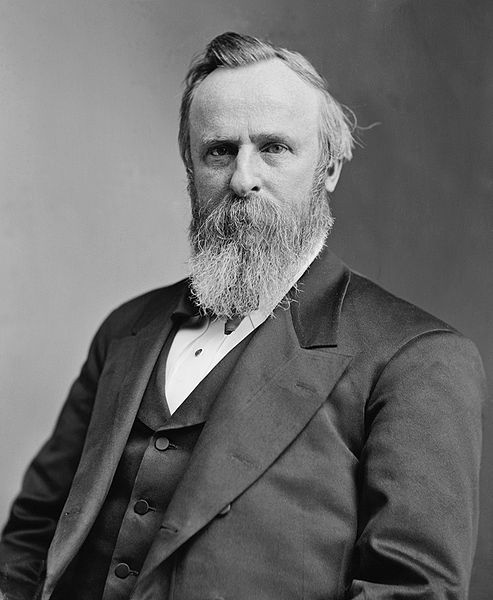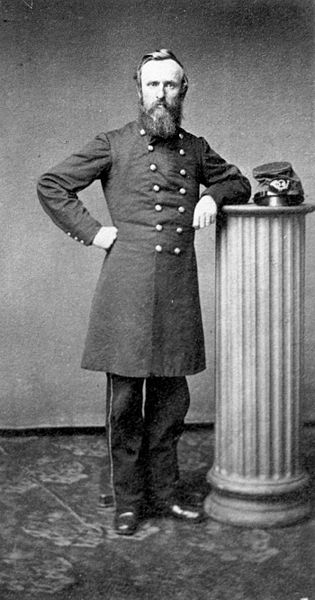| Rutherford Birchard Hayes | |
|---|---|
 |
|
| 19th United States President « Previous Next » |
|
| In office | Mar. 4, 1877 – Mar. 4, 1881 |
| V. President | William Wheeler |
| Political Party | Republican (1854–1893), Whig Party (Before 1854) |
| Personal Info | |
| Born | Oct. 4, 1822 |
| Died | Jan. 17, 1893 (at age 70) |
| Religion | Methodism |
| School | Kenyon College, Harvard Law School |
| Profession | Lawyer |
| Signature | |
| Wife | Lucy Webb |
| Children | Birchard, Webb, Rutherford, Joseph, George, Fanny, Scott, Manning |
| U.S. Presidents 16-25 | |
| 16. Abraham Lincoln (1861–1865) | |
| 17. Andrew Jackson (1865-1869) | |
| 18. Ulysses S. Grant (1869-1877) | |
| 19. Rutherford B. Hayes (1877-1881) | |
| 20. James A. Garfield (1881-1881) | |
| 21. Chester A. Arthur (1881-1885) | |
| 22. Grover Cleveland (1885-1889) | |
| 23. Benjamin Harrison (1889-1893) | |
| 24. Grover Cleveland (1893-1897) | |
| 25. William McKinley (1897-1901) | |
| List of All the Presidents |
A few years after the American Civil War and the same time when the world was about to face the Second Industrial Revolution, Rutherford Birchard Hayes attempted to reform and lead the United States of America. He was The United States of America’s 19th president and served from 1877 to 1881.
Life before Politics
The president was born on October 4, 1822 from a family in Delaware, Ohio. His father, Rutherford Hayes, was a Vermont storekeeper who tended to a farm and wine distillery, but died before his son was even born. He was then raised by his single mother who never remarried, Sophia Birchard, and was helped by her brother and father-figure to the children, Sardis Birchard, who lived with the family shortly.
Through the efforts of his family and the inspiration of his sister who dreamt of being a lawyer, Fanny Hayes, he pursued his studies at Harvard Law School and became a popular criminal defense lawyer whose frequent services are from those charged with murder and escaped slaves wrongly accused. He was even noted for using an insanity plea and sent his client to a mental institution instead of going to prison.
He married Lucy Ware Webb on 1852, who was known for her high regard on performing good works, temperance as evidenced by maintaining a ban on alcoholic beverages in the White House, and a strong advocate to end slavery. She influenced the views of her husband subtly, and he accompanied her in religious services even though Hayes never joined the Methodist church.
During the Civil War, the then forty-year-old and father to three children become the major for the 23rd Ohio Volunteers despite having no military experience and only underwent a month of training. He was nominated for the House of Representatives in 1864 but refused to leave his comrades, yet he remained to be elected and was able to serve his position at the end of the war.
The Dispute of the 1876 Election
 The political career of Rutherford B. Hayes continued to flourish when he served as the governor of Ohio twice, and was later seen by the Republican Party as a worthy bet to run as president. His campaign for presidency was tough with the economic crisis. The previous administration had a reputation of being corrupt and scandalous, and his opponent Samuel J. Tilden had gained a lot of popular votes.
The political career of Rutherford B. Hayes continued to flourish when he served as the governor of Ohio twice, and was later seen by the Republican Party as a worthy bet to run as president. His campaign for presidency was tough with the economic crisis. The previous administration had a reputation of being corrupt and scandalous, and his opponent Samuel J. Tilden had gained a lot of popular votes.
On the day of the 1876 election, Tilden was leading the votes until Hayes secured the presidency by the Congress deciding to give him these Electoral College votes from the three southern states of Florida, Louisiana, and South Carolina. The Democrats were not happy about this and called him with monikers such as “Rutherfraud” and “His Fraudulency.”
Hayes as President of the United States
 Rutherford Hayes became president after the tarnished and shady years of the Grant administration, hence, he was voted for his reputation of having a high moral integrity, strictness, and eye for making sure that things are well done. This characteristic of Hayes made some of his allies and colleagues in the office dub him as “Old Granny.”
Rutherford Hayes became president after the tarnished and shady years of the Grant administration, hence, he was voted for his reputation of having a high moral integrity, strictness, and eye for making sure that things are well done. This characteristic of Hayes made some of his allies and colleagues in the office dub him as “Old Granny.”
One of the earliest plans of President Hayes to implement Reconstruction to secure the rights of the blacks but his first major act turned out to end this and promote the South to home policy. This is the result of Reconstruction already on its way to fall because of the hatred bred by the military occupation among the southern people and the devotion to the military was waning with troops left only in two states within a few months after inauguration.
President Hayes was a strong believer of education and increased knowledge as a means of developing productive and amicable relations with people across race and ethnic descent. He further pushed on protecting the rights of blacks from the South but all of his efforts were defeated by the white supremacy in these regions and refused to accept the notion of racial equality as well as allocating funds to enforce the civil rights of people.
Aside from the blacks, Hayes was also paternalistic on protecting Native Americans. The lands of the American Indians were being claimed and they are removed from their places of home and work as decided by the Grant administration. Hayes and his secretary of the interior, Carl Schurz abandoned the project and reformed the Indian Bureau. However, a criticism of their administration was that they focused on the acculturation of the natives with teaching of household and domestic skills than attempting to preserve their rich culture.
Rutherford Hayes was also famous for pushing reforms in the civil service by giving federal jobs to people based on their merit such as through an examination that everyone must take. Such reform is a 180 degree turn from the previous spoils system of appointment where patronage and efficiency as political organizers were the basis for landing a position as government employee.
At the same time, this caused fury and conflict with politicians including the Republican Party which was not consulted with political appointments. He tasked his secretaries Carl Schurz and William Evarts to draft bylaws and rules on appointments for federal positions.
This was further followed by internal investigations on corruption of different federal bureaus such as the New York Custom House and the Postal Service. This was brought about by civil servants being more effective in organizing political events than doing their federal jobs, and has a high tendency for corruption and accepting bribes for the sake of the political party or personal gains.
 Rutherford Hayes on June 22, 1877 enacted an executive order which would not allow civil personnel to manage and engage themselves in the events and campaigns of political parties but focus on doing their official responsibilities. Party leaders and politicians argued about this and ignored him because of their belief that complying with this order meant the destruction of the parties.
Rutherford Hayes on June 22, 1877 enacted an executive order which would not allow civil personnel to manage and engage themselves in the events and campaigns of political parties but focus on doing their official responsibilities. Party leaders and politicians argued about this and ignored him because of their belief that complying with this order meant the destruction of the parties.
As president, he was also tasked to address the economic issues left by the Grant administration and the recent Civil War. A debate on currency coinage between silver and gold caused clamor among laborers, famers and businessmen. This passing of the Bland-Allison Act in 1878 caused further confusion among the Americans between which metal has a higher value, and compounded by the desire of the people to redeem greenbacks (flat, paper money) to species (gold).
John Sherman, the Secretary of the Treasury, decided to redeem the greenbacks as requested but the public realized that its value is at par with gold and only a few wanted to redeem these United States Notes. This has caused prevention of inflation and revival of business which all led to economic recovery during the Hayes administration.
The country also experienced conflicts and issues between foreign governments such as the problems with bandits who cross the borders of Mexico thus preventing their capture. Hayes allowed the army to chase these bandits even if it meant crossing the Mexican border causing outrage by the Mexican president, it was through a compromise that both parties would chase these bandits that reduced violence and prevented war. There were also issues on stopping the influx of Chinese immigrants and the people of California discriminating their Chinese residents; and the plans of using the French to build the Panama Canal.
Another interesting thing was Rutherford B. Hayes signed a bill on 1879 allowing female lawyers for the first time to argue cases before the Supreme Court.
Despite the improving economy and his reforms slowly gaining acceptance, Rutherford B. Hayes refused to run again as president in 1880 and this was considered by some people to be a mistake since he limited his time of making changes in the United States. Nevertheless, his legacy as a president who triumphed over people through his values of being respectable, honest and openness to change will never be forgotten.